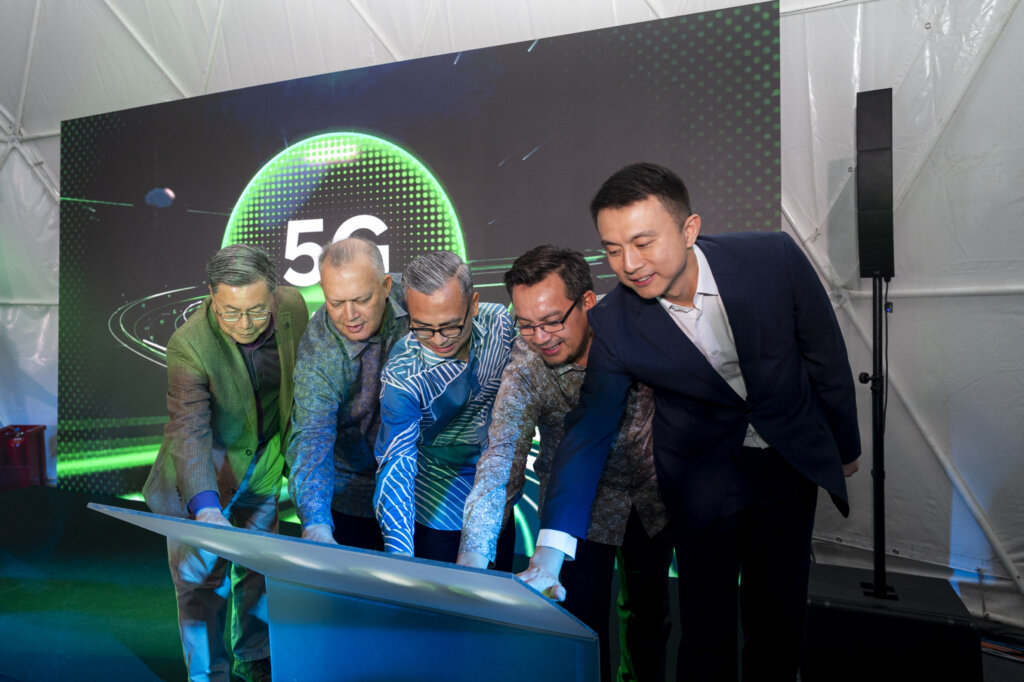
Yang Berhormat Fahmi Fadzil, Minister of Communications officiated the first 5.5G technology trial showcase by Maxis and Huawei.
Maxis and Huawei set a new benchmark with 5.5G trial in Malaysia and Southeast Asia
- Maxis and Huawei spearhead Malaysia’s first 5.5G trial, revolutionizing regional connectivity.
- The potential to enhance Malaysian business and drive investment is significant.
- Maxis enhances telecom landscape with Huawei’s 5.5G tech and strategic investments.
Maxis and Huawei are leading the way in Malaysia and Southeast Asia with the region’s first 5G-Advanced technology trial. This groundbreaking test, dubbed the ‘5G-Advanced Trial Showcase,’ featured a live demonstration of the capabilities of the technology, reaching astonishing peak speeds of up to 8Gbps.
5G-Advanced, also known as 5.5G, is poised to improve connectivity with speed, device connectivity, and latency improvements, offering up to a tenfold enhancement over standard 5G.
The showcase was attended by Yang Berhormat Fahmi Fadzil, the Minister of Communications, and Yang Berbahagia Tan Sri Mohamad Salim Fateh Din, Chairman of the Malaysian Communications and Multimedia Commission (MCMC).
Focusing on demonstrating the power of 5G-Advanced technology, the event showcased digital and connectivity innovations. Held at KLCC The Place, it was the nation’s first 5.5G technology trial.
Maxis and Huawei committing to digital excellence
The demonstration area brought technology to life with interactive features like low-latency live streaming from Kuala Lumpur’s city center, live 3D content, and augmented reality (AR) experiences.
Tan Sri Mohamad Salim bin Fateh Din emphasized the significance of the trial in showcasing the Malaysian telecommunications sector’s potential to significantly enhance communications connectivity.
Tan Sri Mohamad Salim bin Fateh Din expressed his aspiration for more industry players to innovate and help Malaysian enterprises climb the value chain with next-generation solutions. He anticipates Malaysia becoming a global telecommunications leader.

Yang Berhormat Fahmi Fadzil, Minister of Communications officiating the first 5.5G technology trial showcase this morning, accompanied by (from left) Goh Seow Eng, chief executive officer of Maxis, Yang Berbahagia Tan Sri Mohamad Salim Fateh Din, Chairman of MCMC, Yang Berusaha Nik Kamaruzaman Nik Husin, Deputy Secretary General (Strategic Communications and Creative Industry) of the Ministry of Communications and Simon Sun, chief executive officer of Huawei Malaysia.
Goh Seow Eng, CEO of Maxis, highlighted the potential of this technology in powering smart solutions across various sectors. He was eager to delve into this technology for the advancement of industries and the nation’s digital goals.
Simon Sun, CEO of Huawei Technologies (Malaysia) Sdn Bhd, shared insights on Huawei’s efforts in R&D and validation of essential 5.5G technologies and business cases. He announced the launch of Malaysia’s first 5.5G showcase, positioning the country as a regional leader in digital infrastructure and an attractive hub for foreign investment.
5.5G technology is poised to enable significant advancements in digitalization, automation, and the Internet of Things (IoT) across multiple sectors.
These advancements are expected to drive digital transformations in critical industries like high-end manufacturing, automotive, smart transportation, and advanced visual communication through 3D and extended reality (XR). Additionally, 5G-Advanced will facilitate the development of cost-effective IoT solutions.
Strategic investments and industry collaborations
The move to showcase Malaysia’s first 5.5G technology trial is significant, as Maxis is known for accelerating the 5G market, a trend highlighted last year. For example, Maxis’ move to invest in 5G network operator Digital Nasional Bhd (DNB) reflects the industry’s acknowledgment of the platform’s cost efficiency and equitable access.
According to BMI Country Risk and Industry Research, a Fitch Solutions company, telecommunications firms agree that a collective investment in a shared platform is more economical than building separate networks and managing costly interconnection agreements.
BMI noted this decision in a report last year, citing rising inflation and its impact on existing mobile businesses as influencing factors. The Malaysian Communications and Digital Minister, Fahmi Fadzil, announced that Maxis began the process of signing a 5G access agreement with DNB, following the resolution of several issues on July 11 of 2023.
BMI observed that the government’s decision to offer DNB equity to operators allows them to participate in critical commercial decisions, such as vendor selection, infrastructure rollout schedules, and pricing strategies. Maxis’ decision to join other major operators in investing in DNB indicates a shift away from lobbying against the DNB scheme and a reluctance to invest in a proposed secondary 5G network, which may not be commercially feasible.
BMI also posits that the new 5G network might serve as a neutral carrier, attracting smaller entities and virtual service providers. The firm forecasts that by 2032, Malaysia will have 33.8 million 5G connections, making up 75.3% of the total mobile user base, with many supporting Internet of Things applications.
Enhancing customer experience with upgraded services
In addition to these strategic moves, Maxis is enhancing its service offerings. Starting December 14, 2023, customers on Maxis’ new Unlimited Postpaid plans will automatically receive a complimentary upgrade, offering additional 5G data. This upgrade alters the previous 5G data allocations, significantly increasing them across various plan tiers.
This enhancement follows Maxis’ introduction of its new Unlimited Postpaid plan with 5G data in August. For customers on legacy plans, Maxis recommends switching to a new plan to access 5G services, although a temporary 5G access pass is available for free until they upgrade their plan.
This 5.5G trial is set to gain international exposure at the upcoming Mobile World Congress (MWC) 2024 in Barcelona, Spain, where it will be showcased in the Malaysia Pavilion and supported by the MCMC. As a leading Malaysian company, Maxis will represent the nation at MWC 2024, a major global event in the connectivity sector.
READ MORE
- 3 Steps to Successfully Automate Copilot for Microsoft 365 Implementation
- Trustworthy AI – the Promise of Enterprise-Friendly Generative Machine Learning with Dell and NVIDIA
- Strategies for Democratizing GenAI
- The criticality of endpoint management in cybersecurity and operations
- Ethical AI: The renewed importance of safeguarding data and customer privacy in Generative AI applications


